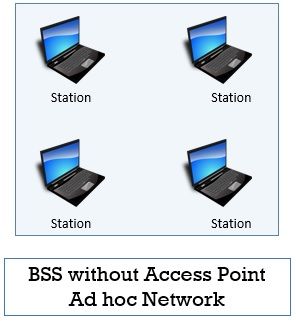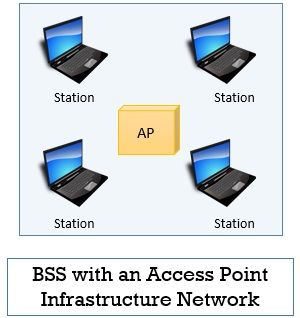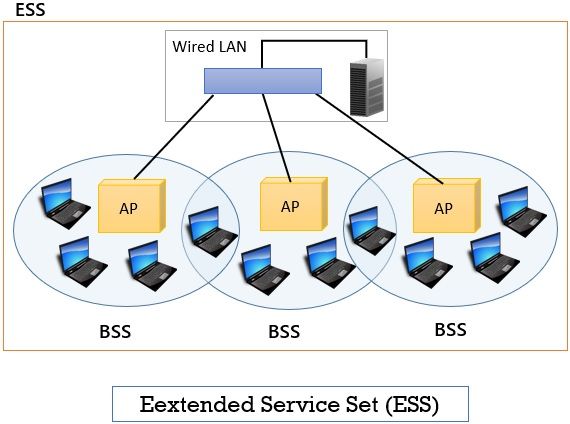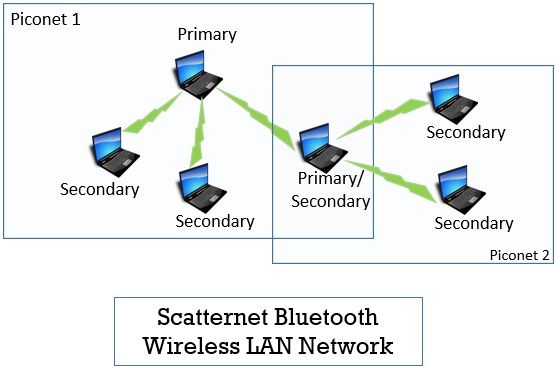Wireless Local Area Network
A wireless local area network is a local area network where the computers are interconnected to each other using the high-frequency radio wave instead of wires and cables. The wireless local area network provides mobility to the end nodes.
In this section, we will discuss wireless local area networks in brief, along with this we will also study the techniques which can be used to implement wireless LAN, we will also discuss their architectures of wireless LAN. Further, we will study the advantages and disadvantages of wireless LAN over wired LAN.
Content: Wireless Local Area Network
Introduction
The wired LANs make use of standard wires and cables to connect the end nodes of the network. The wireless local area network does not use wire or cable to establish connectivity between the nodes instead high-frequency radio waves are used to connect the devices in the network.
Just as we use Ethernet as a communication standard for wired LAN, IEEE has introduced four communication standards for wireless LANs that are 802.11, 802.11a, 802.11b, and 802.11g.
In the section ahead, we will discuss two techniques that we use to implement the wireless LAN that are IEEE standard 802.11 and Bluetooth. We will also discuss the architecture of both techniques. So let us start with IEEE 802.11.
IEEE 802.11 Wireless Local Area Network
IEEE 802.11 is a communication standard for wireless LAN, it defines two layers i.e., physical layer and data link layer which are the first two layers of the OSI model. Let us discuss the architecture of wireless LAN.
Architecture of IEEE 802.11
The implementation of IEEE 802.11 wireless LAN can be classified into two types basic service set (BSS) and extended service set (ESS).
1. Basic Service Set
The basic service set is the basic structure of every wireless LAN. The main components of BSS are stations which can be stationary or mobile stations and the access point which is a central base station. The access point is optional in BSS.
The basic service stations can be further implemented in two ways:
a. Adhoc Network
The basic service set which does not have an access point is referred to as an ad hoc network. The stations in the Adhoc network can’t send data to the stations on other BSSs. This kind of network is a stand-alone network.
As in the ad hoc network, there is no access point so to create a network the stations identify and locate themselves to one another.
For example, your mobile phone creates a spontaneous network .when it sends data to another mobile phone.
b. Infrastructure Network
The infrastructure network has a central base station i.e., access point. All the stations in this network are connected to the access point and can communicate through the access point.
For example, your home or office Wi-Fi network.
2. Extended Service Set
The extended service set is a set of two or more BSSs where each BSS compulsorily has an access point. Here all the BSSs are connected to each other using the wired LAN which connects the access point of all BSSs.
In an extended service set, there are both stationary stations as well as mobile stations in the network. The stationary stations are the access points that are connected using wired LAN and mobile stations are stations inside every BSSs.
Now the stations in BSS that are within the reach of one another do not require access points to communicate with one another but the stations that are far away from one another can communicate with each other through the connected access points.
Discussing all this let’s see how many types the stations can be:
Station Types
- No-transition stations are the stations that can either be stationary stations that can not move from their places or stations that can move within the BSS only.
- BSS-transition stations are the stations that can move from one BSS to another BSS but both the BSS must be inside one ESS.
- ESS-transition stations are the stations that can move from one ESS to another ESS.
Versions of IEEE 802.11
- IEEE 802.11a: This standard operates at the frequency of 5GHz and is able to transfer the data at the speed of 54 Mbps.
- IEEE 802.11b: This standard is slower than 802.11a as it transfers data at the speed of 11 Mbps and it operates at the frequency of 2.4 GHz. As its operating frequency is low it is better in penetrating the physical barriers.
- IEEE 802.11g: This standard operates at the frequency of 2.4 GHz and transfers data at 54 Mbps.
- IEEE 802.11n: This is the recently revised standard introduced by IEEE which can operate at the frequency of 2.4 GHz to 5 GHz and is able to transfer the data at a speed of 600 Mbps.
Bluetooth Wireless Local Area Network
Bluetooth is another technique to implement wireless LAN but of a very short range. This technique connects the devices that have different functional capabilities such as mobile phones, cameras, printers, speakers, and so on.
Bluetooth is an ad hoc kind of network that can be made spontaneously where the devices/gadgets/end nodes locate each other, agree to make a network, and create a network. If one of the devices in the network has the capability to connect with the internet then Bluetooth LAN can be connected to the internet.
By creating a Bluetooth LAN, you can connect a wireless mouse to your computer, you can connect your mobile phone to the speakers, you can even connect two mobile phones, and so on.
The Bluetooth LAN can be classified into two types of network:
Piconet is a small range network that has eight active stations. Among these eight stations, only one station is the primary station, and the rest stations are secondary stations.
The communication in a piconet is always one-to-one or one-to-many. During the data transfer, the secondary station in the piconet needs to synchronize its hopping sequence and its clock with respect to the hopping sequence and clock of the primary station.
Scatternet is a combined net created using several piconets. Here a secondary station of a piconet serves as the primary station for the other piconets.
The data flow like this, from the primary station of piconet 1 to the secondary station of piconet1. Here this secondary station of piconet 1 acts as a primary station to piconet 2 which will transfer the data to secondary stations of piconet 2. In this way, a single station can be a part of two piconets.
The Bluetooth network operates at the frequency of 2.4 GHz and can transfer the data at the speed of 1 Mbps.
Interference
The wireless networks are reliable and convenient but it has the possibility of interference. When two devices try to operate on the same frequency interference occurs which not only degrades the quality of the signal but also reduces the range of the device.
The other reason for interference to radio waves are the metallic substances that have the ability to reflect the radio signals. Even materials with high density are harder to penetrate.
Advantages and Disadvantages
- The wireless LAN is a good alternative where the wired LAN can’t be implemented such as the areas that have geographical limitations like hilly areas.
- The addition and removal of new devices in the network are easier as compared to wired LAN.
- The network can be created spontaneously.
- The cost of installation and maintenance of wireless LAN is comparatively low as compared to wired LAN.
- The wireless network connects a wide variety of devices which has different functional capabilities.
Disadvantages
- The wireless LAN is prone to interference.
- The wireless LAN transfers data much slower when compared to wired LAN.
- Wireless communication requires more security.
So, this is the wireless local area network that provides mobility to its end users but restricts the range of devices. We have seen two technologies that can be used to implement wireless LAN that IEEE standard 802.11 and Bluetooth technology. Among these two, the IEEE standard 802.11 provides a higher data transmission rate.
Related Terms:
How to Set Up a Bluetooth LAN
Bluetooth is an inexpensive option to share files and printers between two computers. As a short-range wireless network, the Bluetooth personal area network (PAN) allows you to link a desktop PC to a laptop and other Bluetooth devices. Before you set up the Bluetooth connection, you will need to install Bluetooth USB adapters in the computers.
Right-click on «My Computer» and select «Properties.» When the «System Properties» menu pops up, go to the «Computer Name» tab.
Press the «Change» button on the «Computer Name» window. The computer name will become the name of the Bluetooth device on a second computer that your computer has recognized. Once the computer name and work group change, restart your computer.
Plug in the Bluetooth adapters into both computers. Go to the Device Manager and click on «Network Connections.» If the Bluetooth device is installed correctly, a Bluetooth Network Connection should appear under «Personal Area Network» with the Bluetooth stack driver on the first computer.
Check «Network Connections» on the second computer. If the Bluetooth device is installed correctly, the Bluetooth adapter will show up as a Local Area Connection under «LAN» or «High-Speed Internet.»
Go to «Bluetooth Settings» on the second computer. Click on «Service Properties.» Check the «PAN Networking Service» on the «Service Properties» window of the second computer.
Go back to the first computer. Right-click on the Bluetooth task bar icon. From the drop-down menu, select “Join a Personal Area Network.” The Bluetooth Personal Area Network window should pop up.
Click “Add.” The “Add Bluetooth Device Wizard” should open. Check “My device is set up and ready to be found” on this window. The Wizard will then search for Bluetooth devices within range.
Once the Wizard identifies the second computer, click «Next.» In the next window, the Wizard will ask you for a passkey or PIN before creating a connection to the second computer. You can input your own passkey or allow Windows to generate one for you.
The second computer will then prompt you to plug in your passkey. Type in the passkey and press «OK.» If the connection process was successful, you will then end on a window with an enabled «Finish» button.
Once finished, you will return to the Bluetooth Personal Area Network window. The second computer will appear under «Direct Connections.» Select it. Then press «Connect» to begin a Personal Area Network connection that is your own LAN.
Items you will need
Bluetooth local area network
Figure: LAN Access or PAN Profile
Bluetooth devices access a LAN via a Bluetooth access point.
If one computer is part of a LAN, it can be used as an access point.
Local Area Network Access Profile (LAP)
LAN Access profile enables a Bluetooth device to access a LAN, WAN, or Internet via another Bluetooth device that has physical connection to the LAN/WAN/Internet. This profile uses PPP (Point-to-Point Protocol) over RFCOMM (emulation of serial cable) for connection establishment. LAP also allows a Bluetooth device to join a Bluetooth ad-hoc network.
The LAN Access Profile is replaced by PAN profile in the new Bluetooth specification. But it is still widely supported by many legacy Bluetooth products.
Personal Area Networking (PAN) Profile
PAN profile allows a Bluetooth device to join a piconet (Personal Area Network) and access LAN resources or WAN (e.g. PSTN, ISDN, GSM, GPRS, CDMA, EV-DO, Internet) via a Bluetooth Network Access Point (NAP). A Bluetooth Network Access Point (NAP) functions as a bridge, router, or proxy that enables connection between Bluetooth devices and a LAN, WAN, or the Internet. Typically, a Bluetooth access point is designed to serve small computing devices that require network access with low power consumption, i.e. handhelds (PDAs) and mobile phones. But, it may also support laptop or desktop computers and other Bluetooth-enabled devices.
PAN profile defines three device roles, i.e. NAP, GN (Group ad-hoc Network), and PANU (PAN User). As a NAP, a Bluetooth device provides access for up to 7 active PANUs to a LAN or WAN. As a GN, a Bluetooth device interconnects up to 7 active PANUs in a group ad-hoc network (piconet). As a PANU, a Bluetooth device can access LAN/WAN via a NAP, join a PAN (piconet) via a GN, or directly connect to another PANU.
Figure: NAP, GN, and PANU roles in PAN profile
NAP connects the piconet to other network.
GN does not provide connection to other network.
PANU is a client to NAP or GN. Two PANUs can communicate directly.
In PAN profile, data (Ethernet) packets are encapsulated using BNEP (Bluetooth Network Encapsulation Protocol) when transferred between Bluetooth devices, therefore it is more bandwidth efficient and faster than LAN Access Profile which requires the establishment of a point-to-point link for each connection between two Bluetooth devices. In addition, the PAN profile also fully supports Internet Protocol (both IPv4 and IPv6) enabling all IP-based services to run over Bluetooth.



